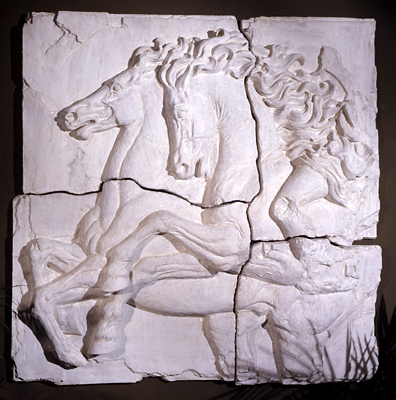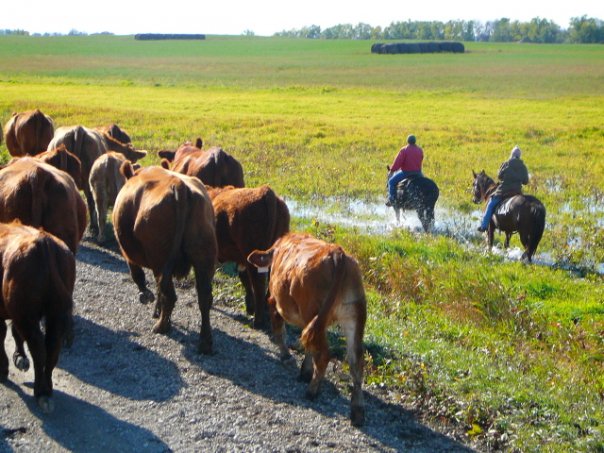The Shepherd

12.16.11 TME
return to
Educated Equestrian
return to
Educated Equestrian
A friend once asked me, when we were sorting cattle, if I’ve ever attempted to saddle break a cow or bull. I think he thought he was joking; I suspect he thought he knew how I would answer. I surprised him by responding, “No, but I’m not opposed to it. Cattle really are just funny looking horses.”
I wouldn’t limit this statement to cattle, either. I enjoy watching our little Nubian goat herd, as the dog brings them around the barn to the hay feeder at chore time. Rounding up cattle or goats, herd work of any kind, involves communication. Basically, I can tell the herd, or any members of the herd, where to go, using their language, the language “herd”. It is a language that is natural to them, but is not auditory in nature. It is tactile in nature, and supported by visual cues. A person who wishes to use the language “herd” to communicate with an animal may do so by indicating any of the four quarters of the animal. Left front, right front, left rear, right rear….a touch on each of these quarters will motivate the corresponding leg and foot. Proving a visual opening at any of these quarters can produce the same effect, in a more subtle way. Often, it’s to our frustration that any opening, gap in the fenceline, is a sort of an “invitation” to a cow, a horse, or a goat to enter. However, this principle often can work to our advantage, if we prepare our space adequately beforehand and provide openings when and where we desire the herd to go.
The principle works just as well with horses, whether you are on the ground, attempting to move the herd, or in the saddle. “Setting it up,” as Ray Hunt has explained, involves some preparatory work. Sometimes, that means making sure our space to work in is appropriate for the work we wish to do. Sometimes, that means making sure our tools, tack and rope, is functional, in good condition, and available to us when we need it. But more than anything, the preparatory work is done inside of us, in our hearts and heads, as we contemplate our lesson plan for the day, and how we view our student--the horse.
"The horse: It is necessary to treat as your equal the faithful servant of whom, to increase your pleasure, you ask the sacrifice of his whole life. He who doesn't have friendship for the horse and is not infused with admiration for this noble animal, is foreign to every good feeling." Baucher
I wouldn’t limit this statement to cattle, either. I enjoy watching our little Nubian goat herd, as the dog brings them around the barn to the hay feeder at chore time. Rounding up cattle or goats, herd work of any kind, involves communication. Basically, I can tell the herd, or any members of the herd, where to go, using their language, the language “herd”. It is a language that is natural to them, but is not auditory in nature. It is tactile in nature, and supported by visual cues. A person who wishes to use the language “herd” to communicate with an animal may do so by indicating any of the four quarters of the animal. Left front, right front, left rear, right rear….a touch on each of these quarters will motivate the corresponding leg and foot. Proving a visual opening at any of these quarters can produce the same effect, in a more subtle way. Often, it’s to our frustration that any opening, gap in the fenceline, is a sort of an “invitation” to a cow, a horse, or a goat to enter. However, this principle often can work to our advantage, if we prepare our space adequately beforehand and provide openings when and where we desire the herd to go.
The principle works just as well with horses, whether you are on the ground, attempting to move the herd, or in the saddle. “Setting it up,” as Ray Hunt has explained, involves some preparatory work. Sometimes, that means making sure our space to work in is appropriate for the work we wish to do. Sometimes, that means making sure our tools, tack and rope, is functional, in good condition, and available to us when we need it. But more than anything, the preparatory work is done inside of us, in our hearts and heads, as we contemplate our lesson plan for the day, and how we view our student--the horse.
"The horse: It is necessary to treat as your equal the faithful servant of whom, to increase your pleasure, you ask the sacrifice of his whole life. He who doesn't have friendship for the horse and is not infused with admiration for this noble animal, is foreign to every good feeling." Baucher

It is not uncommon to find people in the horse industry who have forgotten the horse is their friend. Perhaps they enjoy the profits of the sale. Some seek the glory of winning in a showring, or displaying their talent (and that of the horse) in a performance of some other kind. There is not a thing wrong with enjoying your horse’s athleticism or exhibiting; but one must remember, the horse is in our care. We are responsible for the health, well-being, and comfort of those in our care, those who do not have a voice or legal
"The horse is a member of a herd. The rider, an individual. The work with a horse permits the rider to share the feeling of becoming a member of that horse's herd, and through the work, that unique horse is given the sense of being an individual. Each gives something neither would ever feel without the other." Craig Stevens
Our livestock, our horses, cattle, goats, make us better people. In order to care for the herd, we often forget ourselves. We pull calves out of mudholes and freezing water. We brave the wind and snow to open watering holes and bring out the feed. We care for their wounds and share joy in the births and reunions. We forget our own discomforts, our hunger, cold, tiredness, to shepherd them. In this selflessness, we become better people, patient people, with self-discipline and concern for the community at large. Only after developing our own temperance and compassion may we see the individual horse before us, and attempt to train him.
"The horse cannot be corrected by all kinds of harsh punishments, but by the science and the patience of those who correct and train. "Pierre de La Noue
"Whenever the trainer finds himself in a situation where he has difficulties in controlling his own will, where he wants to become too strong and force the horse to give him the result he is looking for, he must convince himself that the means are against the purpose." Adam Ehrengranat
Horse training, cattle ranching, goat herding, is more than a job. It is a frame of mind, a lifestyle, a dedication to a life of service and shepherding. The educated equestrian understands that often, the work needed to improve his horse begins with work that must first be done within.
Our livestock, our horses, cattle, goats, make us better people. In order to care for the herd, we often forget ourselves. We pull calves out of mudholes and freezing water. We brave the wind and snow to open watering holes and bring out the feed. We care for their wounds and share joy in the births and reunions. We forget our own discomforts, our hunger, cold, tiredness, to shepherd them. In this selflessness, we become better people, patient people, with self-discipline and concern for the community at large. Only after developing our own temperance and compassion may we see the individual horse before us, and attempt to train him.
"The horse cannot be corrected by all kinds of harsh punishments, but by the science and the patience of those who correct and train. "Pierre de La Noue
"Whenever the trainer finds himself in a situation where he has difficulties in controlling his own will, where he wants to become too strong and force the horse to give him the result he is looking for, he must convince himself that the means are against the purpose." Adam Ehrengranat
Horse training, cattle ranching, goat herding, is more than a job. It is a frame of mind, a lifestyle, a dedication to a life of service and shepherding. The educated equestrian understands that often, the work needed to improve his horse begins with work that must first be done within.
representation. We are the shepherds, who care for our flocks, not only because they provide for us. We are shepherds because of our love for the individuals in our care.